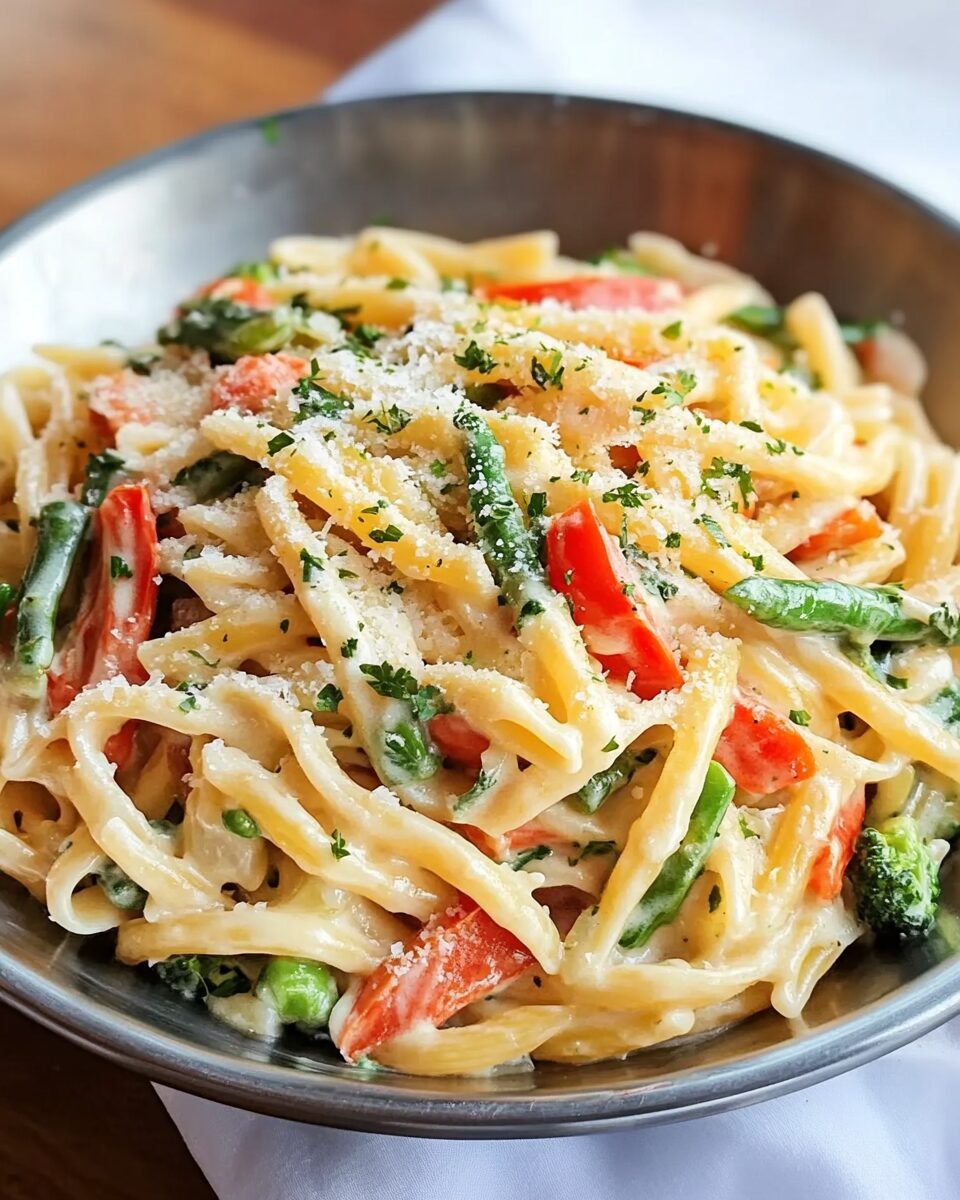Origin and Culinary Influence
Although “primavera” means “spring” in Italian, Pasta Primavera is actually an Italian-American invention. It rose to fame in the 1970s in New York City and quickly became a staple in upscale restaurants across the United States. The dish was created as a way to showcase fresh, seasonal produce, blending Italian pasta traditions with American creativity and a penchant for creamy sauces.
This recipe continues in that tradition, but with a modern update. Instead of a heavy cream-based sauce, it uses a combination of chicken broth and half-and-half to create a silky, flavor-rich base that’s lighter yet still indulgent. The blend of soy sauce, mustard powder, and bouillon adds umami depth, while a sprinkle of red pepper flakes keeps things interesting.
Why This Recipe Works
Pasta Primavera stands out for its smart balance of taste and texture. It works because every element is designed to complement the others:
-
Creamy but light sauce: The blend of broth and dairy brings body without heaviness.
-
Bold seasoning: With dried herbs, mustard powder, and a hint of hot sauce, the sauce is far from bland.
-
Fresh vegetables: Each veggie is sautéed to keep its integrity—slightly crisp and bursting with color and nutrients.
-
Lemon and parmesan: These finishing touches brighten and round out the sauce, adding complexity to each forkful.
The success of this recipe lies in the contrast it creates—between rich and light, creamy and crunchy, hearty and fresh. Every bite is layered and flavorful, with the kind of balance you’d expect from a fine-dining experience.
Reasons to Love This Pasta
-
Vegetable-forward: A fantastic way to incorporate more produce into your meals, even for veggie skeptics.
-
Customizable: Use whatever vegetables are in season or in your fridge.
-
One-skillet preparation: Fewer dishes, more flavor, and less hassle.
-
Family-friendly: Kids and adults alike love the creamy texture and cheesy flavor.
-
Make-ahead convenience: Ideal for meal prepping; leftovers reheat well and often taste better the next day.
This dish satisfies comfort cravings while still feeling bright and nutritious—making it a weeknight hero and a dinner party star.
Health Benefits
Despite its creamy nature, Pasta Primavera is a nutrient-dense option when prepared thoughtfully. Here are some of the benefits packed into each bowl:
-
Vegetables like broccoli, carrots, zucchini, and bell peppers are rich in vitamins C, A, and K, as well as fiber and antioxidants that support immunity and digestion.
-
Garlic and onions have anti-inflammatory and heart-healthy properties.
-
Half-and-half provides calcium and protein, while offering a lighter alternative to heavy cream.
-
Olive oil and chicken broth contribute healthy fats and minerals without overpowering the dish.
-
Parmesan cheese not only enhances flavor but also adds calcium and essential amino acids.
By using a homemade sauce with controlled ingredients, you avoid the excess sodium and additives found in store-bought pasta sauces. If you’re vegetarian, simply swap the chicken broth with vegetable broth, and you still get the same flavorful base.
Serving Suggestions
Pasta Primavera is a full meal on its own, but it can also be paired with simple sides to complete your dinner table:
-
Crusty garlic bread or focaccia for dipping in the creamy sauce.
-
A light side salad with lemon vinaigrette to balance the richness.
-
Roasted chicken or shrimp if you want to add extra protein.
-
A crisp white wine like Sauvignon Blanc or Pinot Grigio enhances the herbs and lemon in the dish.
This dish also makes an excellent lunchbox option—just portion it into individual containers and reheat gently for a delicious midday meal.
Tips for the Best Pasta Primavera
-
Use fresh vegetables for the brightest flavor and best texture. Don’t overcook them; a slight crunch keeps the dish vibrant.
-
Grate your own parmesan cheese—pre-shredded varieties often contain anti-caking agents that affect texture and melting.
-
Stir the sauce constantly while thickening to avoid lumps and ensure a smooth finish.
-
Add lemon juice at the end, not while simmering, to preserve its brightness and tang.
-
Cook pasta just until al dente, especially if you plan to reheat leftovers—this keeps it from getting mushy.
Recipe Variations
There are countless ways to make Pasta Primavera your own:
-
Make it gluten-free: Use your favorite gluten-free pasta like chickpea, lentil, or rice-based options.
-
Go vegan: Swap half-and-half with cashew cream or coconut milk, use vegetable broth, and a vegan Parmesan alternative.
-
Add protein: Grilled chicken, shrimp, or white beans can turn this into a protein-packed entrée.
-
Change the pasta: Penne, farfalle, fusilli, or even spaghetti work well depending on what you have on hand.
-
Add greens: Toss in baby spinach, kale, or arugula at the end for an extra nutrient boost.
This flexibility ensures you can enjoy the dish year-round, adapting it to what’s in your pantry or what’s freshest at the market.
Conclusion
Restaurant-style Pasta Primavera is a perfect fusion of comfort and nutrition, rich flavor and visual appeal. It’s a versatile, vibrant dish that brings together everything we love about pasta with the wholesomeness of a garden full of vegetables. With its creamy herb-parmesan sauce, crisp-tender veggies, and zesty lemon finish, every bite offers a balanced and satisfying experience that feels indulgent without being overly heavy.
Whether you’re serving it for a cozy weeknight dinner, impressing guests at a gathering, or simply looking to enjoy more vegetables in your meals, this Pasta Primavera checks every box. It’s simple, beautiful, and packed with flavor—and most importantly, it proves that vegetables can indeed be the stars of the show. Let it become a staple in your kitchen, one you return to again and again with seasonal twists, delicious leftovers, and happy smiles all around.






